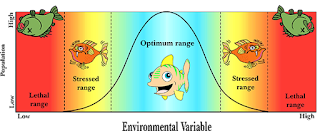Indicator Species
Indicator Species
Indicator
species, organism—often a microorganism or a plant—that serves as a measure of
the environmental conditions that exist in a given locale. Indicator species
are chosen for their sensitivity to environmental conditions. Example of
indicator species such as:
·
Plants, algae,
mosses, and fungi
- The presence of certain species of plants suggests how
well other species might grow in the same place.
-
Mosses often
indicate acid soil.
-
Greasewood
indicates saline soil
-
In Vancouver,
Canada, the environmental health of estuaries is monitored by the indicator
species of eel grass.
-
Lichens, which are
a combination of an alga and a fungus growing together, are indicators of air
pollution, especially sulfur dioxide, a waste product of burning
sulfur-containing fossil fuels. In Great Britain, bushy lichens grow only in
clean air. Leafy lichens tolerate some air pollution and crusty lichens can
survive with higher levels of pollutants. If no lichens are present, it usually
indicates heavy air pollution.
-
Tubifex worms
indicate oxygen-poor and stagnant water unfit to drink.
-
Amphibians, Adult
frogs and toads live on land and in water and are good indicator species since
the skin of the adults is moist and permeable, allowing numerous pollutants
entry into their bodies. Tadpoles live in water and indicate water quality
issues.
-
Amphibians make
good indicator species because we live in two environments, land and water, and
have thin skin that we sometimes breathe through. Our thin skin can also absorb
toxic chemicals, radiation, and diseases. If there are lots of frogs and other
amphibians in a habitat, it means the ecosystem is healthy.
Fish
Salmon
are an indicator species for wetland ecosystems of Greater Vancouver as well as
over the greater Pacific Rim. The National Wildlife Federation lists them as species
at risk due to pollution, river channelization, dams, deforestation and urban
sprawl. Commercial farmed salmon increase the chance that accidental
interbreeding occurs and that diseases could spread into wild populations.
http://education.seattlepi.com/examples-indicator-species-4123.html










Nice ais, mungkin bisa ditambahkan penjelasan mengapa lumut dijadikan indikator tanah yang asam ?
BalasHapusAku setuju sama ruri mungkin bisa ditambahkan
BalasHapusNice information, ternyata banyak sekali organisme yang bisa dijadikan sebagai organisme indikator
BalasHapus